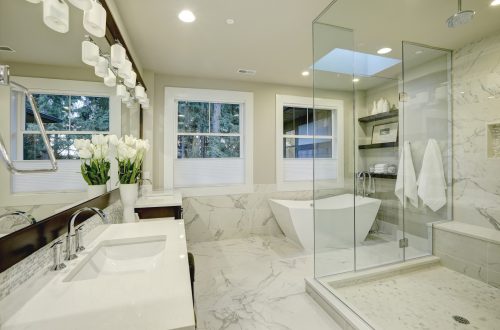Oil vs. Water Polyurethane Finish
Which hardwood flooring finish is better and which lasts longer?
Oil based polyurethane or Water-borne polyurethane….
There are many factors to think about when deciding on the finish of your hardwood floor. We’ve given some key points to consider when making your decision.
Here are some factors to consider that might sway your decision either way:
Durability: How long will the finish last before it has to be redone?
Oil based poly is simply, more durable and lasts about twice as long as water based polyurethane. It’s due to the chemical makeup; oil based poly’s have 45% to 50% of solids, while water based polys only contain 30% to 35% of solids. These solids are what make up the poly’s protective finish. Water based poly is thin, and you’ll need at least 4-5 coats, as opposed to 2-3 coats of the oil based. It really is hard to say just how long each finish will last. However, as a general rule of thumb, oil based floors should be screen and recoated every 5-7 years; while floors finished with a water poly should be screen and recoated every 3-5 years.
Are you planning on living in the home while the finishing process is taking place?
We do recommend our customers vacate while the refinishing is being done. Although, if that’s not an option, it’s tricky but not impossible to work while living in the home- it just takes some planning and usually doing the work in 2 or more phases (i.e. Dining area and living room first. Then, kitchen and bedrooms second). We’d have to take a look at the entry and exits to make sure there is a proper way to leave and come back into the home without stepping on the floors being worked on. We can move the furniture as needed.
Smell: The fact is, both oil based and water based polyurethane have an odor. The water based poly might have a bit less of an odor, but in the long run, thinking about the integrity of your finish, smell shouldn’t be a deciding factor convincing you to choose the water based polyurethane. However, water based poly has lower VOC’s (Volatile Organic Compounds) making it a “Greener” choice, but again, it’s a “catch 22”, seeing how the life of your hardwood floor will be cut short, due to refinishing twice as often, ultimately leading to the cutting down of more trees in order to create new hardwood flooring.
Aesthetics: Are you keeping your hardwood floors natural and without stain?
Hardwood flooring is beautiful, and we’re always going to recommend what’s going to keep it that way. One of the only times we’d recommend a water based polyurethane is when installing a light colored hardwood floor and keeping it natural, without stain, or a Gray stained hardwood floor. Maple Hardwood flooring is a great example of this. When a customer asks for a natural maple floor, this is one of the only times where a water based poly would be recommended, simply for the fact that its color is clear, whereas oil based polyurethane has a warm yellow tone, and continues to yellow over time. On a wood species like red or white oak, the natural undertones just beg for the oil based polyurethane which brings out all its beautiful characteristics and graining.
Cost…what is more cost effective?
Ultimately, the oil based polyurethane is more cost effective. There are a few reasons for this:
First, the oil based polyurethane lasts longer and you’d have to refinish half as often;
(so knowing you’d have to refinish your floors in a few years, doesn’t make much sense, looking at it from a cost perspective).
Second, the water based polyurethane itself is more expensive than the oil poly.
Third, you have to use more polyurethane when using water based. Because water based poly is thinner than oil based poly, you’ll need more product to achieve a sufficient finish on the hardwood. For every 2-3 coats of oil based poly, it’s recommended to do 4-5 coats of water based poly.
Differences in drying times…
Here’s where a water based poly might start looking good for some people…
Often, we encounter customers who are eager to move into new homes, or have very tight time frames for a job to be completed. Being that water based poly has a much faster dry time, it often catches the attention of some customers who need it done in a hurry. In most instances, two coats of water based poly can be applied in one day, cutting the length of the job down. Each coat of oil based poly needs a full 24 hours to dry (and that’s with the climate in the home being optimal; there are factors such as humidity that lengthen it’s drying time). However, we always advise our customers that it’s more beneficial to be patient and do it right the first time, decreasing the need to refinish their floors more frequently.
When using a Water Based poly makes the most sense.
There are times when using water based polyurethane is completely recommended.
Certain types of flooring and stains look best with a water based finish. The water base poly does not yellow or amber over time the way oil does. Oil based poly has a tint of yellow and over time, it tends to darken and amber. When staining a hardwood floor gray, for example, it’s definitely best to choose the water based poly. Oil based poly has a yellow tint will affect the gray stain especially over time as it oxidizes and darkens. Maple flooring is a prime example of when choosing the water base poly is recommended. Maple is a beautiful light cream color floor. The color and look is one of the main reasons homeowners choose this floor. If you are going to keep this flooring natural or stain it a light color- water base is the best option.
Can you mix water and oil based polyurethanes? Or can you change from water to oil based without re-sanding?
No, it is never recommended to mix the 2 finishes. But, you can change the finish from a water poly to an oil poly. Say for example you just finished the floors with a water based poly and the outcome just isn’t what you envisioned, it’s best to wait at least 6 months before sanded and refinishing or screening and recoating to use an oil finish. You cannot put oil poly over a freshly finished floor where water based poly was used.
When can we start using our floors after they have been finished?
Oil:Once the last coat of oil has been applied it’s best to wait at least 24 hours before walking on the floors with socks. After 48 hours, you can walk with shoes. When putting furniture back on the floors it’s best to wait 4 days. We recommend waiting at least 2 weeks for dogs (especially larger dogs). And for area rugs, 30 days is what we recommend waiting because that’s how long it takes for the floors to fully cure.
Water: Once the last coat has been applied you should wait 4-6 hours with socks, one day for shoes. Furniture can go back on the floors after 2 days. For dogs, wait one week before letting them walk on the floors. Water poly takes about 30 days to cure as well so it’s best to wait that long for area rugs.
It’s definitely best to decide whether oil based poly or water based poly is right for you before its time for the first application of the finish.
If you have any questions, feel free to call us.
Ultimately, you get more “bang for your buck” when you choose an oil based polyurethane.
Not only does it give you a more durable finish, but it costs less and has to be redone half as often as a water based polyurethane.
We understand how confusing all these factors can be, and we’re here to make the decision process as simple and painless as possible for all our customers.


43 Comments
Pingback:
Pingback:
Pingback:
Pingback:
Pingback:
Pingback:
Pingback:
Pingback:
Pingback:
Pingback:
Pingback:
Pingback:
Pingback:
Pingback:
Pingback:
Pingback:
Pingback:
Pingback:
Pingback:
Pingback:
Pingback:
Pingback:
Pingback:
Pingback:
Pingback:
Pingback:
Pingback:
Pingback:
Pingback:
Pingback:
Pingback:
Pingback:
Pingback:
Pingback:
Pingback:
Pingback:
Pingback:
Pingback:
Pingback:
Pingback:
Pingback:
Pingback:
Pingback: